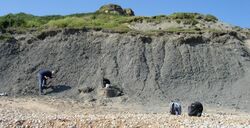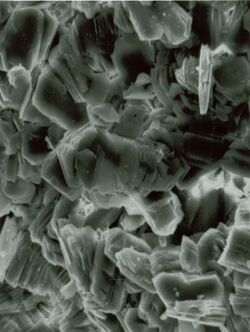Chemistry:Clay minerals

Clay minerals are hydrous aluminium phyllosilicates, sometimes with variable amounts of iron, magnesium, alkali metals, alkaline earths, and other cations found on or near some planetary surfaces.
Clay minerals form in the presence of water[1] and have been important to life, and many theories of abiogenesis involve them. They are important constituents of soils, and have been useful to humans since ancient times in agriculture and manufacturing.
Properties

Clays form flat hexagonal sheets similar to the micas. Clay minerals are common weathering products (including weathering of feldspar) and low-temperature hydrothermal alteration products. Clay minerals are very common in soils, in fine-grained sedimentary rocks such as shale, mudstone, and siltstone and in fine-grained metamorphic slate and phyllite.
Clay minerals are usually (but not necessarily) ultrafine-grained (normally considered to be less than 2 micrometres in size on standard particle size classifications) and so may require special analytical techniques for their identification and study. These include x-ray diffraction, electron diffraction methods, various spectroscopic methods such as Mössbauer spectroscopy, infrared spectroscopy, Raman spectroscopy, and SEM-EDS or automated mineralogy processes. These methods can be augmented by polarized light microscopy, a traditional technique establishing fundamental occurrences or petrologic relationships.
Occurrence
Given the requirement of water, clay minerals are relatively rare in the Solar System, though they occur extensively on Earth where water has interacted with other minerals and organic matter. Clay minerals have been detected at several locations on Mars,[2] including Echus Chasma, Mawrth Vallis, the Memnonia quadrangle and the Elysium quadrangle. Spectrography has confirmed their presence on asteroids including the dwarf planet Ceres[3] and Tempel 1[4] as well as Jupiter's moon Europa.[5]
Classification
Clay minerals can be classified as 1:1 or 2:1, this originates because they are fundamentally built of tetrahedral silicate sheets and octahedral hydroxide sheets, as described in the structure section below. A 1:1 clay would consist of one tetrahedral sheet and one octahedral sheet, and examples would be kaolinite and serpentine. A 2:1 clay consists of an octahedral sheet sandwiched between two tetrahedral sheets, and examples are talc, vermiculite and montmorillonite.
Clay minerals include the following groups:
- Kaolin group which includes the minerals kaolinite, dickite, halloysite, and nacrite (polymorphs of Al
2Si
2O
5(OH)
4).[6]- Some sources include the kaolinite-serpentine group due to structural similarities.[7]
- Smectite group which includes dioctahedral smectites such as montmorillonite, nontronite and beidellite and trioctahedral smectites for example saponite.[6] In 2013, analytical tests by the Curiosity rover found results consistent with the presence of smectite clay minerals on the planet Mars.[8][9][10]
- Illite group which includes the clay-micas. Illite is the only common mineral.[6]
- Chlorite group includes a wide variety of similar minerals with considerable chemical variation.[6]
- Other 2:1 clay types exist such as sepiolite or attapulgite, clays with long water channels internal to their structure.
Mixed blue layer clay variations exist for most of the above groups. Ordering is described as random or regular ordering, and is further described by the term reichweite, which is German for range or reach. Literature articles will refer to a R1 ordered illite-smectite, for example. This type would be ordered in an ISISIS fashion. R0 on the other hand describes random ordering, and other advanced ordering types are also found (R3, etc.). Mixed layer clay minerals which are perfect R1 types often get their own names. R1 ordered chlorite-smectite is known as corrensite, R1 illite-smectite is rectorite.[11]
History
Knowledge of the nature of clay became better understood in the 1930s with advancements in x-ray diffraction technology necessary to analyze the molecular nature of clay particles.[7] Standardization in terminology arose during this period as well[7] with special attention given to similar words that resulted in confusion such as sheet and plane.[7]
Structure
Like all phyllosilicates, clay minerals are characterised by two-dimensional sheets of corner sharing SiO
4 tetrahedra and/or AlO
4 octahedra. The sheet units have the chemical composition (Al,Si)
3O
4. Each silica tetrahedron shares 3 of its vertex oxygen atoms with other tetrahedra forming a hexagonal array in two-dimensions. The fourth vertex is not shared with another tetrahedron and all of the tetrahedra "point" in the same direction; i.e. all of the unshared vertices are on the same side of the sheet.
In clays, the tetrahedral sheets are always bonded to octahedral sheets formed from small cations, such as aluminium or magnesium, and coordinated by six oxygen atoms. The unshared vertex from the tetrahedral sheet also forms part of one side of the octahedral sheet, but an additional oxygen atom is located above the gap in the tetrahedral sheet at the center of the six tetrahedra. This oxygen atom is bonded to a hydrogen atom forming an OH group in the clay structure. Clays can be categorized depending on the way that tetrahedral and octahedral sheets are packaged into layers. If there is only one tetrahedral and one octahedral group in each layer the clay is known as a 1:1 clay. The alternative, known as a 2:1 clay, has two tetrahedral sheets with the unshared vertex of each sheet pointing towards each other and forming each side of the octahedral sheet.
Bonding between the tetrahedral and octahedral sheets requires that the tetrahedral sheet becomes corrugated or twisted, causing ditrigonal distortion to the hexagonal array, and the octahedral sheet is flattened. This minimizes the overall bond-valence distortions of the crystallite.
Depending on the composition of the tetrahedral and octahedral sheets, the layer will have no charge, or will have a net negative charge. If the layers are charged this charge is balanced by interlayer cations such as Na+ or K+. In each case the interlayer can also contain water. The crystal structure is formed from a stack of layers interspaced with the interlayers.
Biomedical applications of clays
As most of the clays are made from minerals, they are highly biocompatible and have interesting biological properties. Due to disc-shape and charged surfaces, clay interact with a range of macromolecules such as drugs, protein, polymers, DNA, etc. Some of the applications of clays include drug delivery, tissue engineering, and bioprinting.
Mortar applications
Clay minerals can be incorporated in lime-metakaolin mortars to improve mechanical properties.[12]
See also
- Chemistry:Clay chemistry – The chemical structures, properties and reactions of clay minerals
- Earth:Expansive clay – Clay soil with high smectite content and prone to swelling and shrinking
- Mudstone/clays on planet Mars
- Earth:Reverse weathering
References
- ↑ "Formation and Occurrence of Clay Minerals". Clays and Clay Minerals 1 (1): 19–32. 1952. doi:10.1346/CCMN.1952.0010104.
- ↑ Georgia Institute of Technology (20 Dec 2012). "Clays on Mars: More plentiful than expected". Science Daily. https://www.sciencedaily.com/releases/2012/12/121220144201.htm.
- ↑ "The surface composition of Ceres: Discovery of carbonates and iron-rich clays". Icarus 185 (2): 563–567. 2006. doi:10.1016/j.icarus.2006.08.022. http://irtfweb.ifa.hawaii.edu/~elv/icarus185.563.pdf.
- ↑ "The origin of life in comets". Int. J. Astrobiol. 6 (4): 321–323. 2007. doi:10.1017/S1473550407003941.
- ↑ Greicius T (26 May 2015). "Clay-Like Minerals Found on Icy Crust of Europa". NASA. http://www.nasa.gov/jpl/news/europa-clay-like-minerals-20131211.html.
- ↑ 6.0 6.1 6.2 6.3 "The Clay Mineral Group". 1996. http://mineral.galleries.com/minerals/silicate/clays.htm.
- ↑ 7.0 7.1 7.2 7.3 "Summary of recommendations of AIPEA nomenclature committee on clay minerals". Am. Mineral. 65: 1–7. 1980. http://www.minsocam.org/msa/collectors_corner/arc/nomenclaturecl1.htm.
- ↑ Agle DC, Brown D (12 Mar 2013). "NASA Rover Finds Conditions Once Suited for Ancient Life on Mars". NASA. http://www.jpl.nasa.gov/news/news.php?release=2013-092. Retrieved 12 Mar 2013.
- ↑ Wall M (12 Mar 2013). "Mars Could Once Have Supported Life: What You Need to Know". Space.com. http://www.space.com/20187-ancient-mars-life-curiosity-faq.html. Retrieved 12 Mar 2013.
- ↑ Chang K (12 Mar 2013). "Mars Could Once Have Supported Life, NASA Says". The New York Times. https://www.nytimes.com/2013/03/13/science/space/mars-could-have-supported-life-nasa-says.html. Retrieved 12 Mar 2013.
- ↑ X-Ray Diffraction and the Identification and Analysis of Clay Minerals (2nd ed.). Oxford: Oxford University Press. 1997. ISBN 9780195087130. OCLC 34731820.
- ↑ Andrejkovičová, S.; Velosa, A.L.; Ferraz, E.; Rocha, F. (2014). "Influence of clay minerals addition on mechanical properties of air lime–metakaolin mortars" (in en). Construction and Building Materials 65: 132–139. doi:10.1016/j.conbuildmat.2014.04.118.
